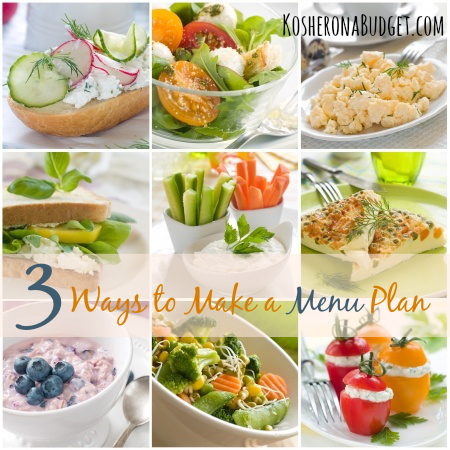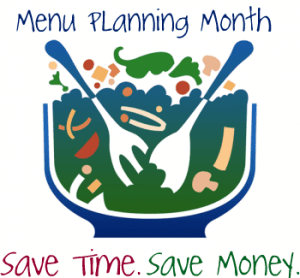Welcome back to 30 Days to a Better Menu Plan here at Kosher on a Budget. Today we’re discussing HOW to menu plan.
The truth is that there’s no right way or wrong way to menu plan.
Actually, scratch that. There is a right way: The way that works for you & your family!
Since I find myself fielding numerous questions about HOW to make your menu plan, I thought I’d put together this review of what I see as the three basic “methods”.
Feel free to adopt one – or mix and match the parts from each that work best for your family.
Method 1: Make a Plan Based on the Foods That Your Family Likes To Eat
Hello, Captain Obvious. I mean, why would you make a plan based on what your family doesn’t like to eat?
The truth is that all methods of menu planning should include meals that at least a few members of your family will like*. But in this method, preference is pretty much the only determining factor in what you plan to eat.
This is how I made my menu plans for a long time. I’d solicit input from my husband, my kids and myself and then put together a menu with a week’s worth of quick, easy and palatable meals.
Then I’d take that menu and write down the ingredients I was going to need to buy. I’d add to the list our favorite breakfast and lunch foods, and then head off to the store. We saved money and time by menu planning this way, but not as much as we would have with method 2 or 3.
(*Here’s my disclaimer to planning what your family likes to eat: As the mom to a pickier eater, I will tell you that pleasing his palate is not my ultimate goal with every meal. Doing so would require me to serve tuna noodle casserole four days a week – and hot dogs the other three! At this point, I aim to expand his palate, more than please it.)
Method 2: Make a Plan Based on What You Already Have at Home
With the first method, you make a plan based solely on what you want to eat that week. With this method, you make a plan based on what you already have on hand, first, and what you want to eat, second.
For example, let’s say you open up the fridge and see some fresh spinach and half a container of Ricotta cheese. To me, those ingredients lend themselves perfectly to spinach lasagna. And since I probably also have lasagna noodles in my pantry, this meal is essential “free”. Now all I need is salad and maybe a loaf of Italian bread.
When you plan this way, you may find that your availability ebbs and flows. Some weeks, you will have the makings of a couple of meals already on hand. Other weeks, you really will be starting from scratch.
But when you “shop” your kitchen first, your out of pocket that week is always going to be lower. Plus, doing it this ways helps to minimize food waste, which, in our experience, is the fastest way to blow your food budget.
Method 3: Make a Plan Based on What’s On Sale
When I first started learning about menu planning, I saw a lot of frugal bloggers reference this method as the pinnacle of money saving.
Here’s how it works: You sit down with the circulars (or your favorite frugal blogger’s deal match-ups) and circle the hot deals. Then you figure out how to use those items as the foundation of your menu plan, filling in with a few purchased items – or better yet, things you already have at home.
I can totally appreciate that this method would save a lot of money, but, in most cases, it probably works best for non-kosher keepers. Again, the other frugal blogs that I read often incorporate deals on treif meats when they are marked down to less than $2/lb (no, you did not just detect a hint of jealousy. Okay, maybe a little.)
For example, if I didn’t keep kosher and I saw that boneless, skinless chicken breasts were on sale for $1.79/lb, I’d be planning chicken stirfry, chicken pot piet and BBQ chicken for dinner. At less than $2 per pound, I could afford to make multiple chicken dinners in a week. But since I pay $5.99 a pound or more – I like to stick to having our chicken on Shabbat.
By now, you may be wondering just how I make my family’s menu plan. The truth is I rely on a little bit of all three methods – with one more twist thrown in. But I’ll explain all that in an upcoming post.
For now, I’d love to hear about your method Are you more of a 1, 2 or 3 type planner? Or do you do something different entirely? See you in the comments!
Image credit: wiktory / 123RF Stock Photo

















I love your menu planning tips. I just started doing 2 week plans and it is working out quite nicely. Thanks for all the advice!
We do a combo of 2, then 1, then 3… basically we start out looking in the pantry/freezer (which really only has the foods we like). Then, if we need to supplement what we already have, we add foods to the menu that we like. If we happen to see a sale while doing the shopping, we’re open to adjusting the menu.
We have a running list of entrees that we like, and we try to mix them up a bit. Since last month was our first real attempt at menu planning, we just sat down last weekend and looked at the menu plan (and entree list) to determine what we liked and what we could skip for a while. This week, our big success was converting leftovers into lunch (hello, savings) and even into an entirely different meal. Intentionally leftover chicken and rice were supplemented with many veggies + seasoning/sauce to make egg rolls and fried rice.
We’ve also been known to write “veggie tba” on our menus to account for upcoming sales.
one thing I do that’s helped us a lot is we have a day for everything – a soup day, a fish day, a pasta day, a breakfast for dinner day, etc.
i’ve been couponing so long that my pantry has almost anything I need in it…. I also get veggies every other week from a co-op – so all I need is meat or fish – for meat I just get what’s cheapest at the butcher and portion it out and freeze…. (I buy big packages – they call them family packs here)
I would love to know what’s on sale before I go shopping, but (as far as I know) there aren’t circulars mailed around like that in Israel. I tend to make my weekly plans based on what we like that we haven’t had in a little while, since I prefer to vary it up a lot.
If we were home for all the Shabbos meals (= I cooked plenty), then Sunday night is often leftovers. We also do soup + garlic pita wedges once a week, maybe even twice during the winter.
I try to make most of my menu planning off of method 2. when we first started menu planning i went through my cookbooks and made great dinners, but we actually spent way more that way. Now I try to be creative with the food we have before I start trying out new foods each night of the week!
Thanks so much for sharing your tips and tricks!